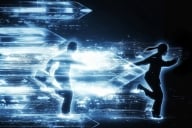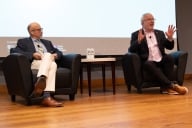You have /5 articles left.
Sign up for a free account or log in.
When it comes to the boundaries between exempted “fair use” of copyrighted materials and unlawful infringement, academic libraries spent 2011 in a defensive crouch.
Last May, a trio of academic publishers, with backing from the Association of American Publishers (AAP), laid out in court documents what they believe to be the limitations of fair use in the context of library e-reserves. Then, in September, the Authors Guild sued a group of research libraries over its attempts to build a shared repository holding digital copies of their collections.
Now the libraries’ own trade group is going on offense — not with a lawsuit, but with a formal set of guidelines that it hopes will help libraries be more confident and less fearful of crossing ordinary copyright thresholds under the auspices of fair use.
The Association of Research Libraries (ARL) has released a “Code of Best Practices in Fair Use for Academic and Research Libraries” — a 32-page document, based on interviews with dozens of librarians, outlining the principles and limitations it believes are relevant to eight common scenarios. The guidelines also recommend additional actions libraries can take to insulate themselves against legal challenges.
“The code isn't really a response or an antidote to any particular lawsuit or group of plaintiffs…. We focused on the eight situations in the code because they are important to libraries; the fact that litigation was happening was in the background, but we focused on the general issues, not the cases,” wrote Brandon Butler, the director of public policy initiatives for ARL, in an e-mail.
Not surprisingly, the first scenario has to do with e-reserves — digital copies of copyrighted works that libraries often made freely available to students for course assignments. E-reserves are at the heart of Cambridge v. Patton, a nearly four-year-old lawsuit against Georgia State University by Cambridge University Press, Oxford University Press and Sage Publications.
Last spring, those publishers — with support from the AAP and the Copyright Clearance Center — filed an injunction laying out what they thought should constitute the thresholds at which fair use becomes piracy: for example, copying more than 250 words of a poem, or 2,500 words of an essay, without paying.
There is no mention of quantitative thresholds in the ARL’s assessment of fair use and e-reserves. Instead there is a single principle: “It is fair use to make appropriately tailored course-related content available to enrolled students via digital networks.” In the association’s view, “appropriately tailored” means “there is a clear articulable nexus between the instructor’s pedagogical purpose and the kind and amount of content involved.”
So long as the use is pedagogically defensible, and the published work is not designed wholly for the purpose of teaching (and so does not rely on payment for educational use to stay viable), there is not necessarily a threshold to how much a librarian can legally copy and make available to students, the guidelines suggest.
“[I]t will not infrequently be the case that access to the entire work (e.g., an illustrative song in a class on the history of popular music) will be necessary to fulfill the instructor’s pedagogical purpose,” the authors write.
Actually having instructors rationalize, in writing, the pedagogical relevance of copied work can give institutions additional legal cover, they add.
Another scenario discussed in the guidelines has to do with developing databases containing digital copies of copyrighted works. Here, too, libraries have faced legal challenges from a trade group. In the fall, the Authors Guild sued HathiTrust — a consortially owned database of digitized library collections — as well as several prominent U.S. research universities involved in its creation. The guild alleged that the universities acted unlawfully several years ago when, without permission, they scanned all the books and periodicals in their stacks and aggregated the digital copies in a shared database.
In the ARL’s view, creating such databases for “nonconsumptive” purposes — i.e., not reading — is legal.
“It is fair use for libraries to develop and facilitate the development of digital databases of collection items to enable nonconsumptive analysis across the collection for both scholarly and reference purposes,” the ARL authors write.
The ARL’s argument is based on the idea that digitizing copyrighted texts so they can be analyzed by computer programs and sorted by search engines sufficiently “transforms” the works so that fair use kicks in.
“Digitizing and indexing works for purposes such as statistical meta-analysis and search creates a powerful new scholarly resource that is not at all a mere substitute for the original work,” the authors write. “The analyses facilitated by scanning for nonconsumptive use do not use the works for their original intended purposes; no person ever ‘reads’ the underlying work or works.”
Publishers in the past have benefited from the fact that the boundaries of fair use are murky. Individual libraries have come up with their own interpretations of the exemptions, and the high visibility of institutions that have faced lawsuits over permissive readings has prompted others to err on the side of caution.
Creating an explicit industry standard for how to read fair use in particular scenarios should give libraries legal cover and encourage them to be bolder in asserting fair use, the code’s authors write. They point out that institutions, even if they are found to be violating copyright, will not have to pay damages so long as they had “reasonable grounds for belief” that they were acting within the law.
The new guidelines give those libraries something to point to. “Simply by articulating their consensus on this subject, academic and research librarians have already lowered the risk associated with these activities,” the authors write.
Tom Allen, the president of the AAP, said the association has not done a full analysis of the ARL’s new codes and has not decided whether to formally rebut them. But Allen did stress that the codes were not negotiated with rights holders, nor do they have the backing of any court. “Clearly, it’s what they want the rules to be,” he said.
For the latest technology news and opinion from Inside Higher Ed, follow @IHEtech on Twitter.








